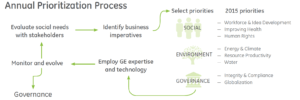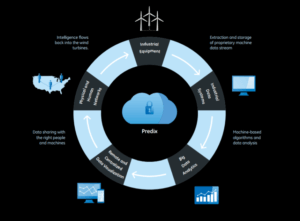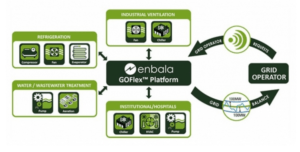General Electric – Not so General anymore!

Tracking how GE is evolving its Culture, Technology, and Organization to battle Climate Change.
General Electric [NYSE: GE] the 124-year-old ‘start-up’ we all recognize from the innumerable home appliance and lighting solutions, operates and has an incredible footprint in almost every facet of industrial and life science technologies ranging from Power Generation, Oil and Gas, Energy Management for building and Industries, Aviation, Transportation, and even Healthcare. [1]
In a recent Harvard Business School interview, Erdogan Cesmile (Director, GE Ventures) called GE “the most future focused, paranoid, innovation driven, technology organization”. Erdogan elaborated, that for the organization to survive the next 125 years it had to fundamentally understand how GE, its products, and its people, directly impacted the world and especially how the organization must continuously evolve and improve to survive the challenges GE and the rest of the world have been facing because of Climate Change. As a result, GE has focused its efforts towards reshaping its culture, its product portfolio, and its organization to prepare both itself and the general industries it touches. [2]
In 2005 GE chose to refocus its culture and launched its Ecomagination initiative. Ecomagination is the company’s commitment to address challenges such as the need for cleaner, more efficient sources of energy, reduced emissions and abundant sources of clean water and especially do ensure that the organization does in a sustainable way that not only shapes industries and the future of industries but also provides value to GE’s shareholders. [3] Today and going forward Ecomagination is GE’s growth strategy to enhance resource productivity and reduce environmental impact on a global scale through commercial solutions, industrial technology, and operations. As part of the initiative, GE has spent $15B in R&D for products and services that improve sustainability. The initiative has resulted in a $200B+ in revenue, 31% lower greenhouse gas emission from its products, and 42% lower freshwater for its clients in the 2005-2014 period. [1] Libby Wayman (Global Director of Innovation, Ecomagination) in the 2016 Harvard Business School Energy Symposium Panel stressed that this focus is going to become more evident in the coming years.
EXHIBIT 1: Ecomagination prioritization process.
Source: GE 2015 Annual Report
In the past decade GE has focused on developing new Renewable Technology products such as onshore and offshore wind turbines, hydropower plants, solar power plants, etc. which has enabled the company to grow its renewable business from a research and development idea to a functional $6B+ business unit within the organization. [4][1] Considering the future for these technologies, costs for these technologies are likely to be driven down due to technological and financial advancements. The next financial innovation for the solar industry is already gaining traction. The solar industry is now adopting a financing vehicle known as a yieldco, which has the potential to attract billions of dollars of investment and further lower financing costs for solar power systems. [5] Similarly for wind turbines, GE expanded its technology development both organically and inorganically (acquiring Alstom) from sub-megawatt wind turbines without any reliable data in 2002 to reliable turbines that can go up to 6 Megawatt and provide predictive maintaince details using GE’s, Microsoft developed cloud service product called Predix in 2015. [7] Both the advancement in the design technology and the Predix software enable solutions for all types of geographical locations and weather conditions. Additionally, climate kits allow operation in deserts or very cold environments. With a design optimized for simple assembly, erection in complex terrains is even easier.
EXHIBIT 2: Renewable energy and the Industrial Internet
Source: GE
GE founded its GE Ventures arm in 2013 and immediately dedicated $150M a year of GE Capital into energy, health, software, and advanced manufacturing startups to accelerate and commercialize innovative ideas and especially focused of directing capital to companies that help GE focus on the challenge of facing climate change. [6] One of the main focuses of the Energy and Catalyst arms of the GE Ventures team has been to find companies that optimize energy efficiency in building technology and city grids to minimize our everyday footprint. Accordingly, the company has invested in companies such as Enbala Energy which has put its software to use connecting, aggregating and managing megawatts’ worth of energy-using systems, such as industrial pumps, refrigerators, and other loads that can be curtailed or ramped up to meet grid needs. [7] The direct implementation of the software in Energy Service Companies (ESCOs) such as utilities plants and other power grids that provide energy to us is that the software is not only to enhance energy efficiency and building system organization but also co-optimizing energy demand from the consumers and energy supply from the energy provider.
EHIBIT 3: Grid management for process for the Enbala
Source: Enbala Energy
[743 words]
[1] ““Integrated Summary Report, – GE.com.” N.p., n.d. Web. 4 Nov. 2016. http://www.ge.com/ar2015/assets/pdf/GE_AR15_Integrated_Summary_Report.pdf
[2] “When Big Companies Work Together They Can Solve The World’s Toughest Problems – GE Reports.” GE Reports. N.p., 2016. Web. 04 Nov. 2016. http://www.gereports.com/lessons-in-collaboration-ecomagination-is-partnering-with-the-worlds-biggest-companies-to-solve-societys-toughest-resource-challenges/
[3] “GE Launches Ecomagination to Develop Environmental Technologies; Company-Wide Focus on Addressing Pressing Challenges.” Press Release Distribution, EDGAR Filing, XBRL, Regulatory Filings. N.p., 2005. Web. 04 Nov. 2016. http://www.businesswire.com/news/home/20050509005663/en/GE-Launches-Ecomagination-Develop-Environmental-Technologies-Company-Wide
[4] “GE 2005 Ecomagination Report: Taking on Big Challenges.” N.p., n.d. Web. 4 Nov. 2016. http://files.gecompany.com/ecomagination/progress/ge_2005_ecomagination_report.pdf
[5] “The Renewable Energy Era — GE, Ecomagination and the …” N.p., n.d. Web. 4 Nov. 2016. http://dsg.files.app.content.prod.s3.amazonaws.com/gereports/wp-content/uploads/2016/02/29123216/GE_Renewables_Digital_020216.pdf
[6] “GE Ventures Launches in Silicon Valley.” Widgets RSS. N.p., 2013. Web. 04 Nov. 2016. http://www.bizjournals.com/sanfrancisco/print-edition/2013/05/24/ge-ventures-launches-in-silicon-valley.html
[7] John, Jeff St. “Enbala Raises $11M to Take Its Buildings-to-Grid Balancing Act to a Bigger Stage.” Green Technology. N.p., 2015. Web. 04 Nov. 2016. https://www.greentechmedia.com/articles/read/enbala-raises-11m-to-take-buildings-to-grid-balancing-act-to-a-bigger-stage







I am following GE Ventures and it’s IoT strategy so find it interesting to see an analysis from climate change perspective, especially about the ecomagination prioritization process.
I agree GE is well positioned to provide manufacturing services to a growing renewable generation industry. They’ve taken steps all along their value chain to prepare. My only concern is a potential shift in the market which would lead to more distributed generation. GE has focused on large players – utility scale generation. Their business model would need to fundamentally change if the trend of residential and small commercial generation accelerates.
EnergEE,
In addition to pursuing renewable generation strategies, GE is also promoting the use of distributed power technologies which help infrastructure function off of a centralized grid. While this is a slow moving process, the changing geographic landscape and risks presented by increasingly volatile storms create an interesting value proposition for such technology. In the short term, GE is promoting the sale of “aeroderivative” technologies, which are aircraft engines re-purposed as turbines. These will likely give way to more renewable distributed technology as the market adopts them, all functioning on a GE distributed power grid.
It is a really fascinating company that doesn’t get the “tech street cred” it deserves. I’ve actually worked on the distributed power strategy for GE in the Eastern/Central Europe and still have friends working on most of the stuff mentioned above (including the IoT and the Alstom integration).
GE has started its pivot back to being more of a pure tech company (I personally call it the “real tech” as opposed to the “bs tech” such as the consumer internet space) in the early 2010’s by divesting many of its financial/non-industrial assets. They are now also looking for ways to move away from the O&G space – the most recent development is the Baker Hughes deal, where GE will divest its O&G assets by merging them with BH in a separately traded entity.
Really enjoyed reading this, especially about GE’s foray into renewable energy technologies. I wanted to learn more and found this interesting little article on an investment they made into biomass, in Indonesia:
http://asian-power.com/project/news/ge-ventures-in-biomass-power-in-indonesia
Also an interesting primer on their website about the distributed power transformation:
https://www.ge.com/sites/default/files/2014%2002%20Rise%20of%20Distributed%20Power.pdf
Subi –
I enjoyed reading about GE and specifically it’s end-markets. GE plays in so many critical areas that will affect climate change. This includes building locomotives, plane engines and even wind turbines. I think one of the most interesting things for GE is the balance they have between the short time and long term. Clearly this business is preparing now for the manner in which climate change will have a long-term impact. However, it is one of the most prestigious, large cap, public companies, known for brutal quarter to quarter targets and a legacy left by Jack Welch’s results driven management orientation. I think this corroborates that even the most profit focused institutions have to take a long-term view when secular change is on the horizon and is undeniable. For GE, climate change certainly fits this criteria.
Thanks Subi, I enjoyed learning more about GE. It is pretty interesting to think about the role that a company like GE can play in helping change the discussion about climate change. After reading your post I am confident that GE is positioning itself to be make sure that climate change does not negatively impact their future business model.
One point your post made me think about was the trade off that GE has to make around short term profitability/growth and long term business strategy. Can GE as a public company spend the necessary capital in the short term to better position themselves to deal with the impact of climate change? I am not convinced that certain shareholders would be happy with GE spending that type of capital instead of on projects that are more NPV positive.